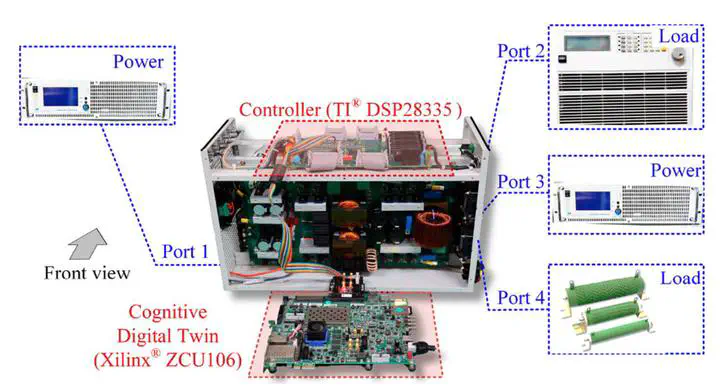Design and Control of High-Frequency DC–DC Converters

Overview
This project builds an end-to-end methodology for high-frequency isolated DC–DC converters—from Dual/Multiactive Bridges (DAB/MMAB) modulation to device-aware models and control integration. We systematize multi-degree-of-freedom (M-DOF) modulation for DAB, generalize it to MMAB via a Universal Phase-Shift (UPS) scheme, incorporate SiC device electro-thermal transients into design, and close the loop with Cognitive Digital Twin–MPC (CDT-MPC) for sensor-lean, high-performance control.
Just Ask for questions!
Explore our research with an AI assistant powered by the latest Gemini models and reliable sources to enhance your understanding and analysis.
Why This Research
- Wide-bandgap + high fs: Operation at 100–400+ kHz stresses soft-switching across wide ratios and loads; classical SPS/DPS loses ZVS and inflates RMS current at off-nominal conditions.
- Multi-port coupling: MMAB efficiency/control suffer from tightly coupled ports and exploding DOFs without a unifying, scalable scheme.
- Device nonidealities: SiC MOSFET/SBD transients and self-heating materially shape losses and thermal design—often ignored in system-level models.
- Control integration: High-frequency dynamics demand global state visibility without high-bandwidth sensors and with strict timing guarantees.
New Measures
- M-DOF Modulation Synthesis for DAB. We connect EPS/DPS/TPS/AMT into a single M-DOF view, showing how zero-level sequences regulate steady-state performance and mapping up to 5 DOFs for H-bridges—providing actionable guidance for soft-switching and loss reduction.
- UPS for MMAB (Generalized Multi-Port). A Universal Phase-Shift scheme yields a time-domain model and a simple, scalable optimization that achieves full ZVS and minimized RMS inductor current across port counts—validated on a four-port prototype.
- Mechanism-Segmentation Transient (MST) Model for SiC. A multi-rate electro-thermal approach segments the physical switching mechanisms of SiC MOSFET/SBD, enabling fast, datasheet-driven loss/temperature prediction for converter-level design.
- CDT-MPC for HF Converters. A mode-driven numerical solver plus online parameter identification forms a cognitive DT that feeds MPC with delay-free global states, delivering dead-beat-like transients without extra high-bandwidth sensors.
Impact
- Efficiency & Soft-Switching: Restores full ZVS over wide operating regions and reduces RMS currents, improving conversion efficiency and thermal margins.
- Scalability: UPS turns a multi-DOF problem into a single-DOF optimization that scales with port number and hardware complexity.
- Device-aware Design: MST-based electro-thermal modeling shrinks the gap between simulation and hardware, guiding magnetics/thermal sizing and reliability.
- Control Performance: CDT-MPC integrates complete-model predictions in real time, cutting sensor latency and improving dynamic response and robustness.